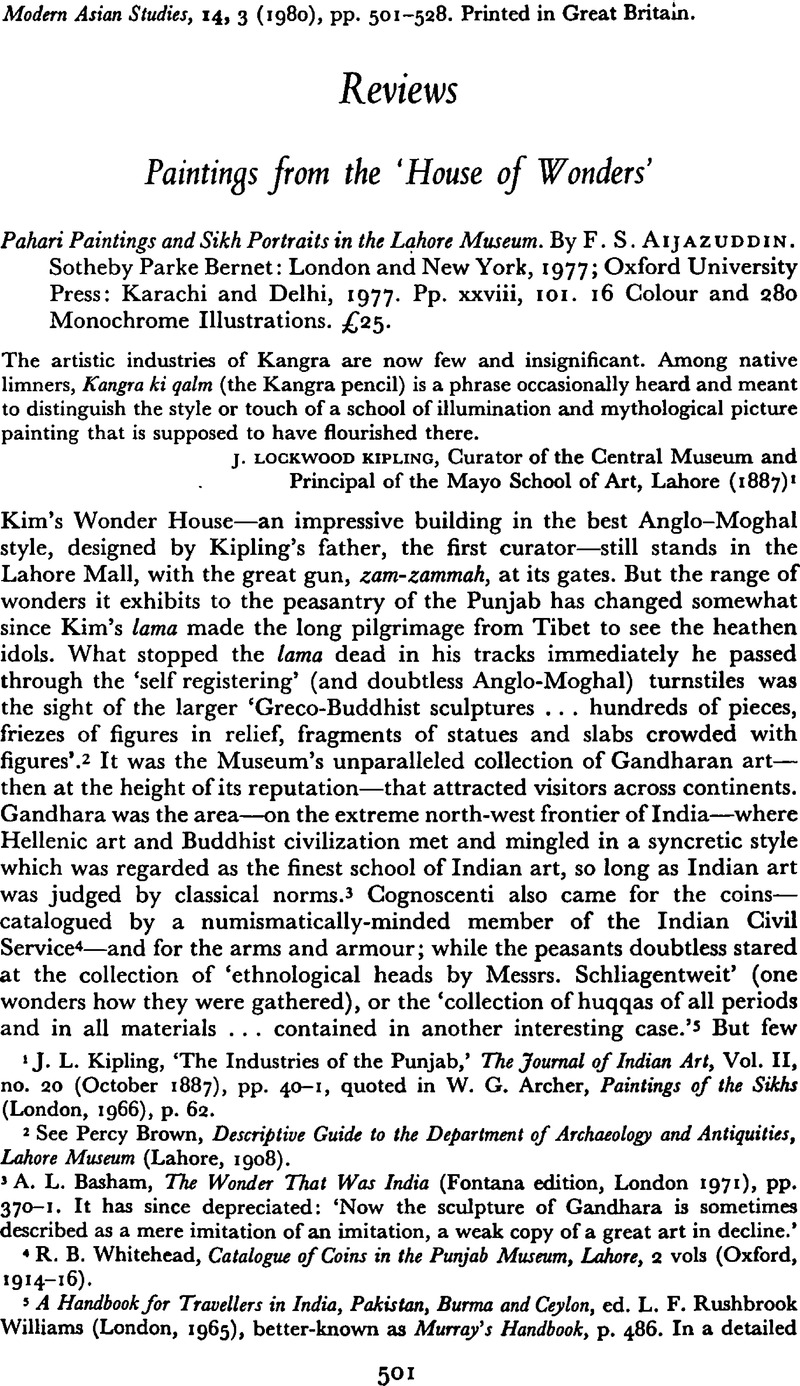No CrossRef data available.
Article contents
Paintings from the ‘House of Wonders’ - Pahari Paintings and Sikh Portraits in the Lahore Museum. By F. S. Aijazuddin. Sotheby Parke Bernet: London and New York, 1977; Oxford University Press: Karachi and Delhi, 1977. Pp. xxviii, 101. 16 Colour and 280 Monochrome Illustrations. £25.
Published online by Cambridge University Press: 28 November 2008
Abstract

- Type
- Reviews
- Information
- Copyright
- Copyright © Cambridge University Press 1980
References
1 Kipling, J. L., ‘The Industries of the Punjab,’ The Journal of Indian Art, Vol. II, No. 20 (10 1887), pp. 40–1,Google Scholar quoted in Archer, W. G., Paintings of the Sikhs (London, 1966), p. 62.Google Scholar
2 See Brown, Percy, Descriptive Guide to the Department of Archaeology and Antiquities, Lahore Museum (Lahore, 1908).Google Scholar
3 Basham, A. L., The Wonder That Was India (Fontana edition, London 1971), pp. 370–1. It has since depreciated: ‘Now the sculpture of Gandhara is sometimes described as a mere imitation of an imitation, a weak copy of a great art in decline.’Google Scholar
4 Whitehead, R. B., Catalogue of Coins in the Punjab Museum, Lahore, 2 vols (Oxford, 1914–1916).Google Scholar
5 A Handbook for Travellers in India, Pakistan, Burma and Ceylon, ed. Williams, L. F. Rushbrook (London, 1965),Google Scholar better-known as Murray's Handbook, p. 486.Google Scholar In a detailed description of the contents of the Museum almost fifteen column-inches long, which (inevitably) begins with the Gandharan sculpture and finds space for a sample of iron ore from Bajaur, there is absolutely no reference to painting.
6 Gupta, S. N., Catalogue of Paintings in the Central Museum, Lahore (Calcutta, 1922).Google Scholar
7 Coomaraswamy, A. K., Rajput Painting (Oxford, 1916).Google Scholar
8 The best account of the problem of attribution is contained in the short yet magisterial introduction to Archer's, W. G.Indian Paintings from the Punjab Hills, 2 vols (London, 1973).Google Scholar
9 See the accounts of Archer's journeys in ibid., pp. xiii–xiv, and passim.
10 Archer, W. G., Indian Painting in the Punjab Hills (London, 1952),Google ScholarArcher, W. G., Kangra Painting (London, 1952);Google ScholarRandhawa, M. S., Kangra Valley Painting (New Delhi, 1954);Google ScholarKhandalavala, K., Pahari Miniature Painting (Bombay, 1958).Google Scholar
11 (London, 1966).Google Scholar
12 See Hutchinson, J. and Vogel, J. P., History of the Punjab Hill States, 2 vols (Lahore, 1933).Google Scholar
13 See Ibbetson's, D. C. J. famous description, originally in the Punjab Census Report for 1881, reprinted in his Punjab Castes (Lahore, 1916), pp. 155ff.Google Scholar
14 Archer, W. G., Indian Paintings from the Punjab Hills, pp. xxi–ii.Google Scholar
15 The most eloquent account of the raja's role in Rajput society in the hills is found in Lyall, J. B., Kangra Settlement Report (Lahore, 1874).Google Scholar
16 Barnes, G. C., Kangra Settlement Report (Lahore, 1862), p. 81.Google Scholar
17 Ibid., p. 82.
18 Few institutions have been so misunderstood as Anglo-Indian Art Schools in nineteenth-century India. The schools did far more to arrest the decline of Indian ‘art-industries’ than they ever did to accelerate it, and their Principals were amongst the most effective advocates of Indian art in the west. See Papers relating to Maintenance of Schools of Art in India as State Institutions, Selections from the Records of the Government of India in the Home Department, CCCLVI (Calcutta, 1898);Google Scholar or Havell, E. B., The Basis for Artistic and Industrial Revival in India (Madras, 1912).Google Scholar
19 Goswamy, B. N., ‘Pahari Painting: the Family as the Basis of Style,’ Marg, Vol. XXI, No. 4 (1968), pp. 17–62.Google Scholar


